If you’re wondering what to do if your dog eats chocolate home remedies, you’re not alone. Many pet owners face this scary situation and need reliable information quickly. Chocolate contains theobromine, a substance that can cause serious medical issues, and treatments may be necessary depending on the amount and type of chocolate consumed. But don’t panic – there are some trusted home remedies that can help your furry friend in a pinch. In this article, we’ll explore the steps you should take if your dog has eaten chocolate and provide some safe, effective home remedies to help them recover.
Key Takeaway
- To protect your dog from chocolate toxicity, keep all chocolate securely out of reach.
- To be prepared for emergencies, know the signs of chocolate poisoning and keep first aid supplies on hand.
- To get proper care, consult your vet immediately if your dog eats certain amounts of chocolate.
- To prevent issues, use dog-safe treats instead of chocolate
Understanding the Risks When Your Dog Eats Chocolate
When a dog has eaten chocolate, it is crucial to understand the risks due to the presence of theobromine and caffeine. These compounds are stimulants that dogs cannot metabolize efficiently, leading to toxic effects. The severity of chocolate toxicity depends on several factors. These include the type of chocolate, the amount eaten, and the dog’s size and weight.
Different types of chocolate contain varying levels of theobromine. Dark chocolate and unsweetened baking chocolate have higher concentrations, making them more dangerous than milk chocolate. Even small amounts of dark chocolate can pose significant risks. White chocolate, on the other hand, contains negligible theobromine but still has high-fat content, which can cause other health issues.
The amount of chocolate eaten and the dog’s size are crucial in determining toxicity. Larger dogs may tolerate more chocolate than smaller dogs, but no amount is truly safe. Use a chocolate toxicity chart to calculate the milligrams of theobromine ingested per kilogram of the dog’s weight. This helps in assessing the potential threat and deciding on the next steps.
If your dog eats chocolate, act quickly. Gather information on when it happened, the type of chocolate, and the estimated amount consumed. Contact your veterinarian immediately for advice. They may recommend inducing vomiting or administering dog-activated charcoal to prevent further absorption of toxins. Keep these emergency supplies on hand for such situations.
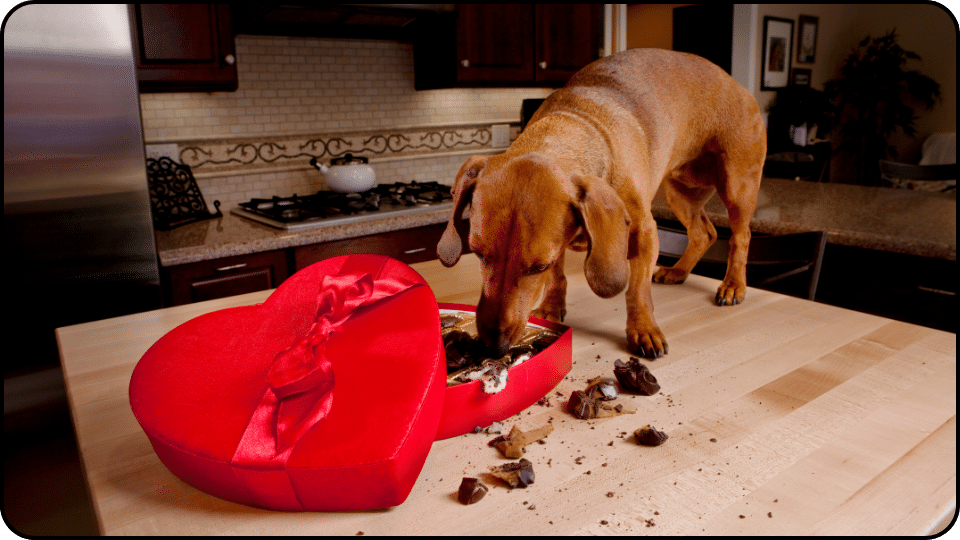
Identifying How Much Chocolate Your Dog Ate
When your dog eats chocolate, gather critical details immediately. Note the time of ingestion and the type of chocolate involved, such as a milk chocolate bar, dark chocolate, white chocolate, or unsweetened baking chocolate. Estimate how much chocolate your dog ate. Also, know your dog’s body weight to assess the risk accurately.
A chocolate toxicity chart can be a valuable tool. It helps calculate the milligrams of theobromine ingested per kilogram of your dog’s weight. This calculation is crucial in understanding the potential threat level. The chart will guide whether your dog has ingested a concerning amount of chocolate, especially if it’s dark or baker’s chocolate.
Time is of the essence when dealing with chocolate ingestion. If your dog has eaten a significant amount of chocolate, particularly dark or baker’s chocolate, act swiftly. Immediate action can make a significant difference in your dog’s prognosis. Contact your veterinarian immediately for guidance on the best course of action.
Even if your dog seems fine initially, monitor them closely. Symptoms of chocolate poisoning may not appear immediately and can develop over a few hours. Look for signs like vomiting, diarrhea, restlessness, rapid breathing, and increased heart rate. Mild symptoms can quickly escalate to severe chocolate poisoning, requiring prompt veterinary care.
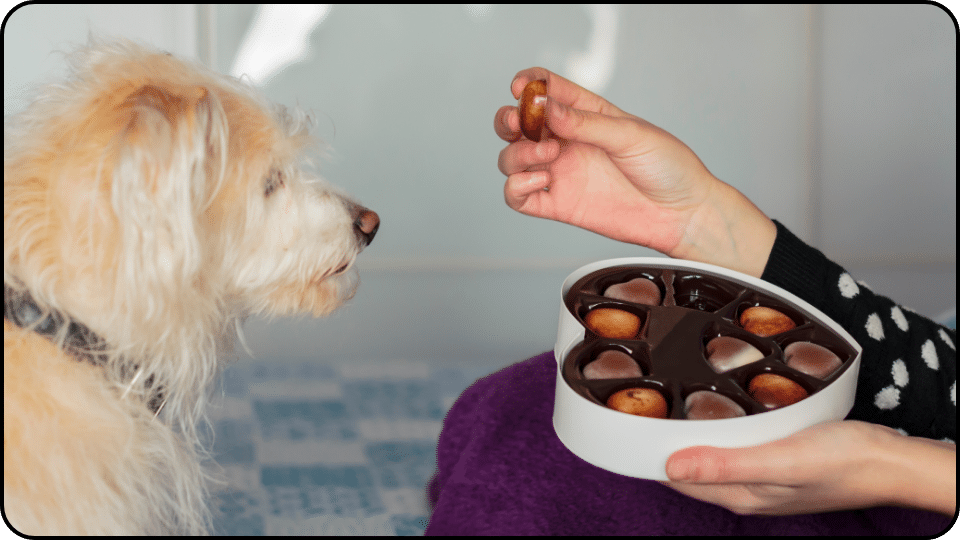
Recognizing the Symptoms of Chocolate Poisoning in Dogs
Symptoms of chocolate poisoning may not appear immediately. They can develop over several hours as theobromine is absorbed into your dog’s system. Initially, your dog might seem perfectly fine, but it’s crucial to stay vigilant. Look for early signs such as vomiting and diarrhea. These symptoms indicate that your dog’s body is trying to expel the toxins.
As time progresses, more severe symptoms may emerge. Restlessness and rapid breathing are common indicators of escalating chocolate toxicity. An increased heart rate is another sign that your dog’s central nervous system is being affected. If you notice these symptoms, it’s important to act quickly. Mild symptoms can rapidly progress to severe chocolate poisoning, necessitating immediate veterinary care.
Even if your dog appears normal after eating chocolate, monitor them closely. Keep an eye on their behavior and physical condition. It’s essential to catch any changes early. If you observe any worrying symptoms, contact your veterinarian immediately. Early intervention can significantly improve your dog’s prognosis.
| Symptom | Severity Level | Action Required |
|---|---|---|
| Vomiting | Mild | Monitor and consult the vet if it persists |
| Diarrhea | Mild | Monitor, provide water |
| Restlessness | Moderate | Contact vet for advice |
| Rapid Breathing | Moderate | Seek veterinary guidance |
| Increased Heart Rate | Severe | Immediate veterinary care |
By recognizing these symptoms and acting promptly, you can help ensure your dog’s safety in the event of chocolate ingestion. Stay informed and prepared to protect your furry friend.
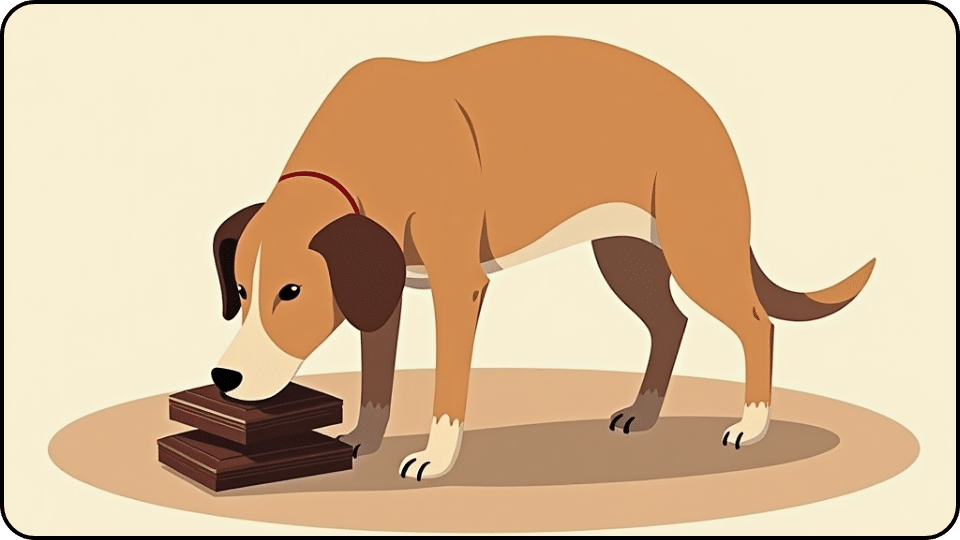
Emergency Response If Your Dog Ate Chocolate
If your dog ingested a large amount of chocolate, consult your veterinarian immediately for advice on inducing vomiting or giving activated charcoal. Acting quickly is crucial to prevent further absorption of the toxic substances found in chocolate. Theobromine and caffeine are particularly harmful to dogs and can lead to severe symptoms if not addressed promptly.
Essential Items for Your Pet First Aid Kit
It’s important to keep essential items in your pet’s first aid kit for emergencies. Include hydrogen peroxide, food-grade activated charcoal, and a syringe. These items can help you take immediate action if your dog eats chocolate. Hydrogen peroxide is often used to induce vomiting, while activated charcoal can help block the absorption of toxins.
- Consult Your Vet: Before inducing vomiting, always consult your veterinarian for guidance. They can confirm if it’s the right course of action based on the type and amount of chocolate ingested.
- Use Hydrogen Peroxide: If recommended, use a 3% hydrogen peroxide solution. Administer it using a syringe, carefully measuring the dose according to your vet’s instructions.
- Wait and Observe: Hold your dog’s mouth closed gently after administering the solution. Wait for about 15 minutes to see if vomiting occurs. If not, consult your vet before repeating the dose.
Follow your vet’s guidance to administer activated charcoal if recommended. This can help prevent theobromine from entering your dog’s bloodstream. Activated charcoal binds to the toxins, reducing their harmful effects.
By keeping these steps and supplies in mind, you can be better prepared to handle situations where your dog eats chocolate. Quick and informed actions can significantly improve your dog’s prognosis and recovery.

Home Remedies for Treating Chocolate Ingestion
When your dog eats chocolate, quick action can make a big difference. If it’s within 1 hour of ingestion, consider inducing vomiting. Use a 3% hydrogen peroxide solution to help your dog expel the chocolate. Administer it with a syringe, carefully measuring the dose. Hold your dog’s mouth closed gently and wait for about 15 minutes. If vomiting doesn’t occur, consult your veterinarian before attempting a second dose.
- Hydrogen Peroxide: Use a 3% solution.
- Dosage: Follow your vet’s guidance for the appropriate amount.
- Repeat if Necessary: Wait 15 minutes before a second attempt, only if advised by your vet.
Consult your vet about administering activated charcoal. This substance can prevent further absorption of chocolate toxins. Activated charcoal binds to the toxins, helping to reduce their harmful effects on your dog’s system. Your vet will provide guidance on the correct dosage and administration.
While your dog recovers, provide supportive care. Offer a bland diet to soothe their stomach and avoid further irritation. Frequent walks can help stimulate digestion and provide comfort. Keep your dog hydrated and monitor for any signs of distress. If symptoms persist, reach out to your veterinarian for further advice.
By following these home remedies and closely monitoring your dog, you can help them recover from chocolate ingestion. Remember, each dog’s situation is unique, so always consult your vet for tailored advice. Quick and informed actions can significantly improve your dog’s prognosis and ensure a safe recovery.
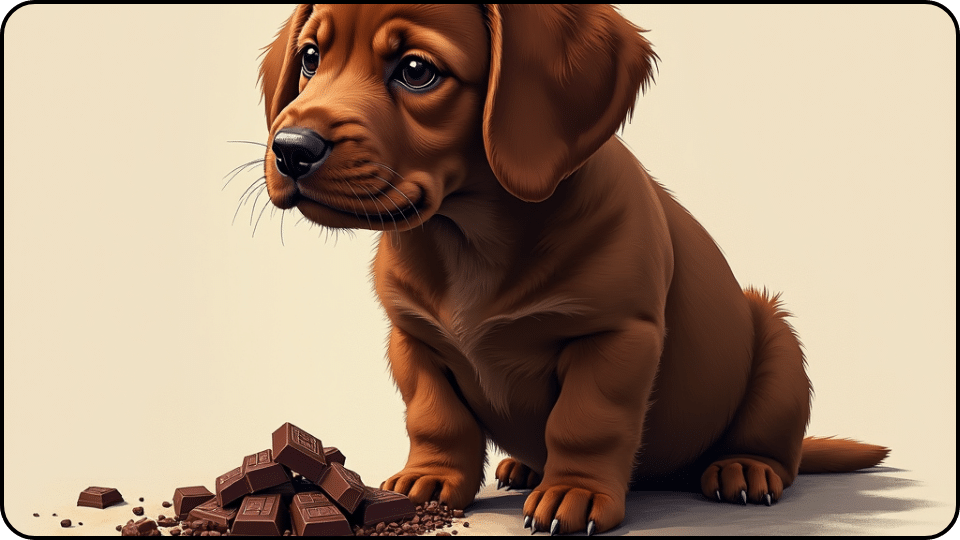
Preventing Your Dog From Eating Chocolate in the Future
Keep all chocolate products securely out of your dog’s reach. Store them in high cabinets or locked pantries where your dog can’t access them. Be mindful of chocolate in unexpected places, like purses or backpacks, which curious dogs might explore. Always supervise your dog during gatherings or holidays when chocolate treats are more likely to be present.
Dog-proof your home to prevent access to chocolate and other hazards. Use child-proof locks on cabinets and drawers that store food. Consider using baby gates to restrict your dog’s access to certain areas. Regularly check your home for potential risks and remove any accessible chocolate or toxic substances.
Use dog-safe carob as an alternative treat instead of chocolate. Carob looks and tastes similar to chocolate but is completely safe for dogs. Offer carob treats to satisfy your dog’s sweet tooth without the risk. Explore other dog-friendly treats such as fruits like bananas or apples, but always in moderation. These options can provide a healthy and safe snack for your furry friend.
By implementing these measures, you can significantly reduce the risk of your dog eating chocolate. Prevention is key to keeping your pet safe and healthy. Always be vigilant and proactive in managing your dog’s environment to prevent chocolate ingestion.

Potential Long-Term Effects of Chocolate Toxicity in Dogs
Repeated chocolate ingestion can cause lasting harm to a dog’s vital organs. The heart, nervous system, and kidneys are particularly vulnerable. Over time, these organs may suffer cumulative damage, leading to serious health issues. Chronic exposure to chocolate can result in heart arrhythmias, nervous system disturbances, and kidney dysfunction. These conditions can significantly affect your dog’s quality of life.
Dogs that consume chocolate frequently are at risk of developing chronic health problems. Theobromine, a toxic component in chocolate, accumulates in their system. This buildup can lead to prolonged health complications. Symptoms might include persistent restlessness, increased heart rate, and even seizures. Chronic exposure can also weaken the immune system, making dogs more susceptible to other illnesses.
Immediate veterinary care is crucial when dealing with chocolate toxicity. Quick intervention can reduce the risks of permanent harm. If chocolate poisoning is caught and treated early, the prognosis is much better. Veterinarians can provide treatments that help eliminate toxins from your dog’s system. They may administer activated charcoal or recommend hospitalization for severe cases.
The key to a better prognosis lies in early detection and treatment. Pet owners should be vigilant and act swiftly if they suspect chocolate ingestion. Recognizing the symptoms early can make a significant difference. If your dog shows signs of chocolate poisoning, contact your veterinarian immediately. Timely medical care can prevent long-term damage and ensure a safer recovery for your furry friend.

Recovery Time and Monitoring – What to Expect After Your Dog Eats Chocolate
Recovery time after a dog eats chocolate can vary. Generally, it may take 1 to 3 days for your dog to fully recover. This depends on the amount of chocolate ingested and the severity of symptoms. Dark chocolate and unsweetened baking chocolate pose greater risks, potentially extending recovery time. Monitor your dog’s behavior closely during this period.
Keep a close eye on your dog for any lingering symptoms. Symptoms such as vomiting, diarrhea, or restlessness may persist. Ensure you follow veterinary guidance when monitoring your dog’s condition. Regularly check for any changes in behavior or physical health. If symptoms worsen or new ones appear, contact your vet immediately.
Veterinary guidance is crucial during recovery. Your vet can offer advice on managing symptoms and provide necessary treatments. They may suggest a bland diet to soothe your dog’s stomach. Frequent walking can help with digestion and comfort. Stay in touch with your vet to ensure your dog’s recovery is on track.
Consider pet health insurance to manage unexpected veterinary expenses. Chocolate toxicity can lead to costly treatments. Insurance can provide peace of mind and financial support. Research different plans and choose one that suits your needs. Being prepared can make a significant difference in your ability to care for your pet.

Immediate Steps When Your Dog Eats Chocolate
If your dog ate chocolate but seems okay, it’s still crucial to call your vet for advice. Even if there are no immediate symptoms, chocolate toxicity can develop over time. Provide your vet with specific details. Share the type of chocolate, the estimated amount eaten, and your dog’s weight. This information helps assess the risk level.
Follow your vet’s recommendations carefully. They may suggest monitoring your dog at home. Alternatively, they might advise bringing your dog in for a more thorough check-up. Each case is unique, and your vet’s guidance will be based on the potential severity of the situation.
If your dog exhibits severe symptoms, seek emergency vet care immediately. Symptoms such as rapid breathing, increased heart rate, or seizures require urgent attention. Don’t wait for symptoms to worsen. Quick action can make a significant difference in your dog’s prognosis. Having a plan for emergency situations is essential for every pet owner.
If advised to monitor at home, keep a close eye on your dog’s behavior. Watch for any changes or new symptoms. Maintain communication with your vet and report any concerns promptly. Monitoring is crucial to catch any delayed symptoms of chocolate poisoning. By staying vigilant, you can ensure your dog’s safety and well-being.
Dog-Safe Alternatives to Chocolate Treats
Carob is a fantastic alternative to chocolate for dogs. It looks and tastes similar to chocolate but is completely safe. Carob doesn’t contain the harmful theobromine or caffeine found in chocolate. This makes it a perfect treat for your furry friend. You can find carob in various forms like chips, powders, and even carob-flavored dog treats. It’s a versatile ingredient that can be used in homemade dog treats.
Fruits can be a delightful treat for dogs. Offer dog-friendly fruits like bananas or apples in moderation. These fruits are not only sweet but also packed with nutrients. Bananas are rich in potassium and fiber, while apples provide vitamin C and antioxidants. Always remove apple seeds and cores before offering them to your dog. Remember, moderation is key to avoiding any digestive issues.
Before introducing new treats, consult your vet. Every dog is different, and what works for one might not work for another. Your vet can provide advice on healthy treat options tailored to your dog’s needs. They can also guide you on portion sizes and frequency. This ensures that your dog enjoys treats safely without compromising their health.
By choosing dog-safe alternatives, you can satisfy your dog’s sweet tooth without the risks associated with chocolate. Stay informed and make treat time both fun and safe for your pet.
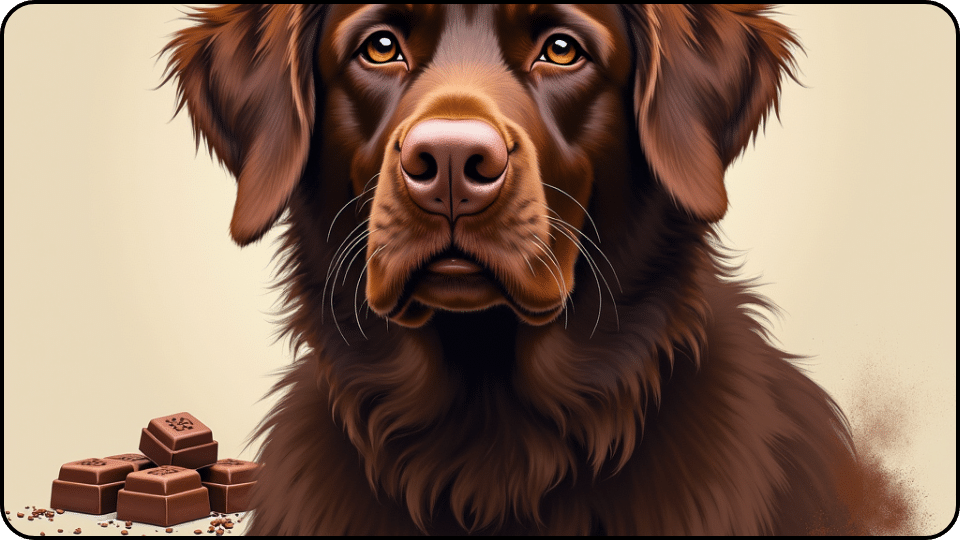
Final Thought
As a responsible pet owner, it’s crucial to be aware of the dangers chocolate poses to dogs and take steps to prevent access. Chocolate ingestion can cause serious health issues due to toxic compounds like theobromine and caffeine. These substances can lead to symptoms ranging from mild discomfort to severe emergencies. Pet owners should understand the risks associated with different types of chocolate, especially dark and unsweetened baking chocolate. Knowing the symptoms of chocolate toxicity and having an action plan is essential for your dog’s safety. Consult your veterinarian immediately if you suspect chocolate ingestion. They can advise on actions like inducing vomiting or administering activated charcoal. Prevention is key, so store chocolate securely and use dog-safe alternatives like carob.
Quick Answers to FAQ
Can a dog survive chocolate poisoning without treatment?
Depending on the amount of cocoa powder ingested before visiting a vet, it may take up to six months for a dog to recover. Studies indicate that 50% of dog fatalities related to chocolate ingestion are due to prolonged vomiting.
How long after a dog eats chocolate will they be ok?
Clinical symptoms can vary based on the amount of chocolate consumed and the dog’s size, typically appearing within two to 12 hours after ingestion. In cases of severe toxicity, these symptoms may persist for 3 to 4 days.
What can I give my dog to throw up after eating chocolate?
Administer three ounces per kilogram of your puppy’s weight, which equates to about a teaspoon per pound. Use a turkey baster to place it on their tongue, and if needed, gently use a syringe to add a bit more. Your puppy should begin vomiting within five to eight minutes after application.
